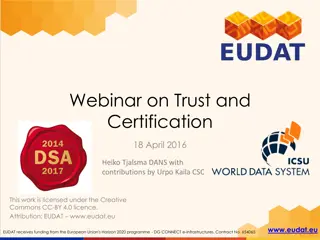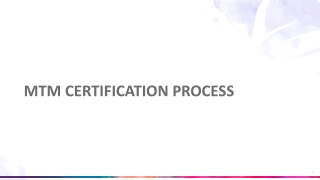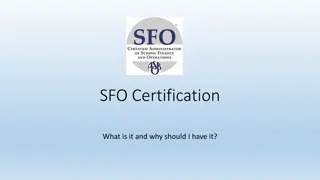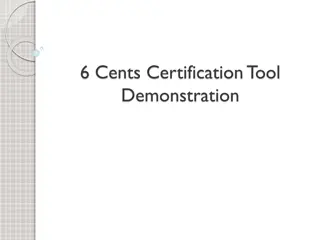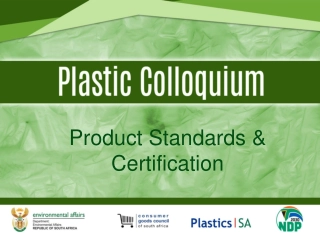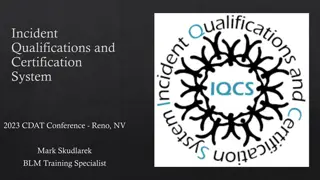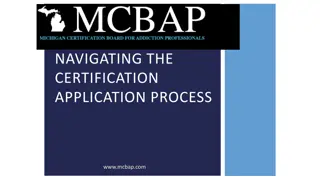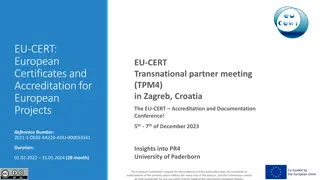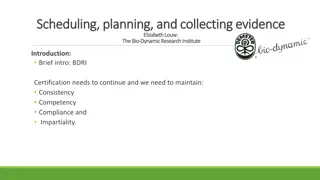CE Certification
CE est lu2019abru00e9viation de Conformitu00e9 Europu00e9enne. Un produit avec le marquage CE signifie quu2019il est conforme u00e0 toutes les lu00e9gislations europu00e9ennes pertinentes couvrant des questions telles que la su00e9curitu00e
Download Presentation

Please find below an Image/Link to download the presentation.
The content on the website is provided AS IS for your information and personal use only. It may not be sold, licensed, or shared on other websites without obtaining consent from the author. Download presentation by click this link. If you encounter any issues during the download, it is possible that the publisher has removed the file from their server.
E N D
Presentation Transcript
CE Certification: Ensuring Compliance and Safety in the European Market Introduction CE certification is a vital component for manufacturers and exporters looking to access the European market. The CE mark, which (European Conformity), indicates that a product meets the essential health, safety, and environmental requirements mandated by European certification is not just a regulatory requirement but a mark of quality and safety that facilitates trade across EU member states. stands for Conformit Europ enne Union (EU) legislation. This The process of obtaining CE certification involves a comprehensive assessment of a product's compliance with EU directives and standards. It encompasses a range of sectors, including electronics, machinery, medical devices, and more. This article delves into the significance of CE certification, the various directives it encompasses, the certification process, and the benefits it offers to businesses seeking to penetrate the European market. 1.The Importance of CE Certification CE certification is crucial for ensuring that products meet the stringent requirements set by the EU, thereby safeguarding consumer health, safety, and environmental protection. It serves multiple purposes that benefit both manufacturers and consumers. a.Regulatory Compliance: CE certification is mandatory for products falling under specific EU directives and regulations. These include directives related to machinery, low- voltage equipment, medical devices, and personal protective equipment. Without the CE mark, products cannot be legally sold or distributed within the EU market. The certification process ensures that products meet the necessary standards and regulations, therebyavoiding legal penalties, market restrictions, and product recalls. b.Market Access and Trade Facilitation: Obtaining CE certification opens up access to the European market, which is one of the largest and most regulated markets in the world. The CE mark acts as a passport for trade, allowing products to move freely within the EU and European Economic Area (EEA). This facilitates easier entry into these markets and enhances trade opportunities for businesses, particularly those looking to expand their reach and establish a presence in Europe. c.Consumer Safety and Confidence: The CE mark signifies that a product complies with rigorous safety and quality standards, providing consumers with assurance about its safety and reliability. By adhering to EU regulations, manufacturers demonstrate their commitment to protecting consumer health confidence among consumers. This is especially important in sectors such as medical devices and electronics, where safety is paramount. and safety, which builds trust and d.Competitive Advantage: CE certification can provide a competitive edge by distinguishing products from those that do not meet EU standards. In a highly competitive market, having the CE mark can enhance a product's marketability and appeal to consumers and
distributors. It signals to stakeholders that the product has undergone thorough testing and complies with EU requirements, potentially leading to increased sales and market share. 2.Key Directives for CE Certification CE certification covers a wide range of products and is governed by various EU directives and regulations. Understanding these directives ensure compliance and achieve certification. is essential for manufacturers to a.Machinery Directive (2006/42/EC): The Machinery Directive applies to machinery and equipment used in industrial settings. It sets out essential health and safety requirements for the design and construction of machinery, including aspects such as risk assessment, safety features, and user instructions. Manufacturers must ensure that their machinery meets these requirements before affixing the CE mark. This directive helps prevent accidents and injuries associated with machinery use and ensures that equipment operates safely. b.Low Voltage Directive (2014/35/EU): The Low Voltage Directive governs electrical equipment operating within certain voltage limits. It focuses on ensuring the safety of electrical products, such as household appliances and industrial equipment, by setting requirements for electrical safety, protection hazards. Compliance with this directive ensures that electrical products are safe for use and meet the necessary performance standards. against electric shock, and fire c.Medical Devices Regulation (2017/745/EU): The Medical Devices Regulation applies to medical devices and in vitro diagnostic devices. It establishes requirements for product safety, efficacy, and quality, including clinical evaluations, risk management, and post-market surveillance. CE certification under this regulation is essential for ensuring that medical devices are safe and effective for their intended use, thereby protecting patient health and safety. d.Personal Protective Equipment (PPE) Regulation (2016/425/EU): The PPE Regulation covers protective equipment designed to safeguard users from hazards such as chemicals, mechanical risks, and extreme temperatures. It sets out performance requirements, testing procedures, and labeling standards for PPE. Compliance with this regulation ensures that protective equipmentprovides the necessary protection and meets quality standards. 3.The CE Certification Process The process of obtaining CE certification involves several stages, each designed to ensure that a product complies with the relevant EU directives and regulations. a.Product Assessment and Classification: The first step in the certification process is to assess the product and determine the applicable EU directives and regulations. This involves classifying the product based on its intended use and identifying the specific requirements that must be met. Manufacturers must review the relevant directives, standards, and technical specifications to understandthe compliance criteria. b.Technical Documentation: Manufacturers must prepare comprehensive technical documentation that demonstrates the product's compliance with EU requirements. This
documentation includes product specifications, design and manufacturing information, risk assessments, test reports, and user instructions. The technical file serves as evidence of compliance and must be maintained for inspection by regulatory authorities or notified bodies. c.Conformity manufacturers may need to undergo a conformity assessment conducted by a notified body. A notified body is an independent organization authorized by the EU to assess the compliance of products with EU regulations. The assessment may involve testing, inspection, and evaluation of the technical documentation to verify that the product meets the required standards. Assessment: Depending on the product and applicable directives, d.CE Marking and Declaration of Conformity: Once the product has been assessed and deemed compliant, manufacturers can affix the CE mark to the product and issue a Declaration of Conformity. The CE mark must be visible, legible, and indelible, and it must be accompanied by the manufacturer's name and address. The Declaration of Conformity is a formal statement by the manufacturer confirming that the product meets all relevant EU requirements. e.Post-Market Surveillance and Compliance: After obtaining CE certification, manufacturers must continue to monitor the product's performance and ensure ongoing compliance with EU regulations. This includes conducting post-market surveillance to identify and address any potential issues or non-conformities. Manufacturers must also keep the technical documentation up-to-date and be prepared for inspections or audits by regulatory authorities. 4.Benefits and Impact of CE Certification CE impacting various aspects of their operations and market presence. certification offers numerous advantages for manufacturers and businesses, a.Access to the European Market: CE certification provides access to the European market, which is one of the largest and most lucrative markets globally. The CE mark allows products to be sold freely within the EU and market opportunities. For businesses looking to enter or grow their presence in Europe, CE certification is essential for compliance and market access. EEA, facilitating trade and expanding b.Enhanced Product Safety and Quality: The CE certification process ensures that products meet high standards of safety, performance, regulations, manufacturers demonstrate their commitment to producing safe and reliable products. This not only protects consumers but also reduces the risk of product recalls, liability claims, and legal disputes. and quality. By adhering to EU c.Increased Consumer Trust: The CE mark is a symbol of quality and safety that can enhance consumer trust and confidence. Consumers often look for the CE mark as an assurance that a product meets stringent regulatory standards. By obtaining CE certification, manufacturers can build a positive reputation and differentiate their products from competitors in market. the
d.Competitive Advantage and Market Differentiation: CE certification provides a competitive edge by demonstrating compliance with recognized standards. This can be a significant differentiator in a crowded market, helping businesses stand out and attract customers. The CE mark signals undergone rigorous testing and meets EU requirements, potentially leading to increased sales and market share. to stakeholders that the product has e.Compliance with Legal Requirements: CE certification ensures that products comply with EU regulations, helping businesses avoid legal issues, fines, and sanctions. By meeting regulatory requirements, manufacturers can operate confidently within the EU market and reduce the risk of non-compliance. This proactive approach to compliance also supports long-term business success and sustainability. Conclusion CE certification is a critical component for manufacturers aiming to access and succeed in the European market. It ensures that products meet essential health, safety, and environmental requirements, facilitating trade and protecting consumers. The certification process involves a thorough directives, technical documentation, and conformity assessment. assessment of compliance with EU The benefits of certification ce extend beyond regulatory compliance, offering advantages such as increased market access, enhanced product safety, and greater consumer trust. By obtaining and maintaining CE certification, businesses can demonstrate their commitment to quality and safety, gain a competitive edge, and expand their presence in the European market. As the global marketplace continues to evolve, CE certification remains a vital tool for ensuringthat products meet the highest standards of safety and performance.





